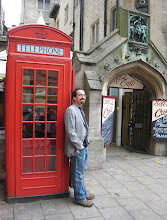
According to the British Arachnid Society, there are no spiders in the UK that eat people. However, looking at the rather large spider who has taken over my backyard in Oxford, I have my doubts.
You can see her for yourself in the picture. For reference, the garbage can in the background is a full size 40 gallon container (150 liters). The spider is about 2.5 cm from fang to spinnerette –a bit over 5cm long if you include the legs. I’m not positive, but I think she is an Argiope Bruennichi, based on the size and the striped legs, but the body doesn’t look quite like the pictures I find online (Any spider experts out there want to comment on this one?).
I had known about the spiders of unusual size (S.O.U.S.) in this country even before I moved here: I had had a frightening close-encounter with a British SOUS on one of my visits to Oxford before moving here (a story for another day). Admittedly, The British spiders aren’t nearly as nasty as the beasts that live in Australia: for example, the Funnel-Web can deliver enough poison to kill a human within 40 minutes, and can bite through most canvas sneakers. This seems to me to be a good reason to avoid the whole continent.
Despite the favorable comparison to the bigger and badder Aussie variety, the somewhat less deadly British critters still give me the creeps. There is some evidence that being afraid of spiders is learned behavior, and children do not naturally have this fear. Nonetheless, the trope of the deadly spider is certainly a common one: Aragog, Shelob, Charlotte. Ok, maybe Charlotte was not supposed to be so threatening, but E. B. White conveniently left out the part of the story where Charlotte mates and then kills and devours her lover. (She lays eggs, so it probably happened). Probably White was censored by his editors since it is a children’s book and one wouldn’t want them reading about spider-sex.
The lifecycle of most of the large British spiders is such that they are born in the spring, they grow through the summer, and get extremely large in the fall just before they mate, lay eggs, and die. I’m traveling for the next three weeks with only one more two day stop back in Oxford, and I’m hoping that Shelob in the backyard will hurry up and get on with the mating, laying eggs, and with luck she will be stone-cold by the time I get back. As far as encouraging the mating part, I left a disco ball in the window and some incense in the backyard.

2 comments:
Ha! Somewhere, I have a picture of "Horace" whom we found on our interior stairway one night. It was hard to catch him inside a water glass because his legs spanned the entire diameter. (It would be a crime to squish such a magnificent beast!)
Oxford grows the best spiders in England. And, I'm sorry to say that most British houses have a double wall of brick, with air vents, and it's a perfect place for spiders to hibernate...
Hey Greg! Had no idea you were here too... In case you don't remember, we overlapped a few years at Bell.
Post a Comment